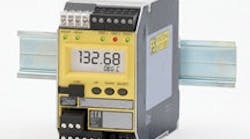It shows you’re on the same page as your colleagues and that your hardware and software will operate reliably, and so you can rely on the support of all of them. In turn, it means you don’t have labor in solitary or redo as much blankety-blank work as before, and can instead focus on newer, higher-priority problems. Nowhere is this trust more important than in the process industries, which is why U.S. and international process engineers are turning more to the IEC 61508 standard for functional safety of electrical/electronic/programmable electronic safety-related systems (E/E/PES), and demanding more compliant interface instruments for their critical process safety applications. To meet these growing needs, Moore Industries has introduced its new Safety Trip Alarm (STA). The alarm trip provides high- and/or low-relay alarm outputs to warn of unwanted process conditions, ensures emergency shutdown, or allows on/off control in safety-related and traditional alarm-trip applications.
Moore adds that its STA earns the trust of its users by achieving SIL 2 and 3 ratings, and by gaining third-party safety approval from Rheinland TÜV this past December.
As the first member of Moore’s new Functional Safety (FS) series, this high-availability alarm trip is designed for SIL 2 applications, which are covered by IEC 61508—Parts 1, 2 and 3. STA also is approved for single use in safety instrumented systems (SISs) up to SIL 2, and its firmware is suitable for a SIL 3 configuration. This allows implementation in a redundant architecture (1oo2, 2oo3, etc.) up to SIL 3.
“Other companies say they’re SIL 2-compliant if they go through a third-party assessment of their organization and processes, and then self-certify their products later,” explains Lockhart. “However, our customers wanted third-party approval from TÜV itself of products and their development processes, so TÜV reviewed our design, conducted audits, and even inserted faults to exercise the firmware in STA’s microprocessor.”
STA is a four-wire (line/mains-powered) device, and can accept signal input from transmitters (current and voltage inputs), temperature sensors (RTD and thermocouple inputs), resistance and potentiometer devices, and a range of other monitoring and control equipment.
In addition, STA provides three fail-safe alarm outputs. Two configurable process alarms trip when a monitored process variable falls outside of user-set high or low limits. Thanks to its self-based and external diagnostics, the third alarm will trip if internally diagnosed faults and external faults occur, such as loss of sensor or poor quality input.
“STA has the two regular process trip alarms that can be set for high or low conditions, but the third always acts as a fault alarm,” adds Lockhart. “So, whenever there’s a wrong input, such as a wire break, this gives users a separate alarm output that they can wire however they want, so they can get an alert without having to shut down their process.”
Also, STA includes comprehensive, certified safety data, which can be used by a functional-safety professional to determine the unit’s applicability to specific safety-related applications. Finally, STA features 20-bit input resolution; long-term stability of up to five years between scheduled calibrations; a rugged, metal housing; and isolation and RFI/EMI protection against ground loops, plant noise and radio frequency and electromagnetic interference. The unit also features standard “transmitter excitation” to provide 24-V power to a two-wire transmitter. STA also can be ordered with an analog output option—that’s not part of the safety path—to provide a combination alarm trip and transmitter in one compact unit.
“Because the STA is the first product in our FS Series, we’re also planning to use this knowledge in other products,” says Lockhart. “These will include safety temperature transmitters and safety signal converters, which also will have third-party certification from TÜV.”
For more information, contact Moore Industries at 818.894.7111; send an e-mail to [email protected]; or visit www.miinet.com




